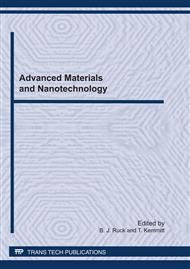p.125
p.129
p.133
p.137
p.141
p.145
p.150
p.154
p.158
Arrays of Au Nanoparticles on Si Formed by Nanoindentation and a Simple Thermal/Wipe-Off Technique
Abstract:
This study demonstrates a novel technique for the fabrication of ordered arrays of Au rich nanoparticles on a Si substrate. Si substrates, with their native oxides intact, are pre-patterned using nanoindentation to create regions on the surface that readily alloy at higher temperatures with a thin thermally evaporated Au layer. Larger Au rich particles are observed to form at the indentation sites after high temperature annealing in an inert atmosphere. After mechanical wiping, the Au rich particles lying within the indentation sites remain while almost all the particles on the native oxide surface are readily removed. Using PECVD techniques, multi-prong Si nanowires are shown to grow from the remaining arrays of Au rich particles.
Info:
Periodical:
Pages:
141-144
Citation:
Online since:
September 2011
Authors:
Keywords:
Price:
Сopyright:
© 2012 Trans Tech Publications Ltd. All Rights Reserved
Share:
Citation:


